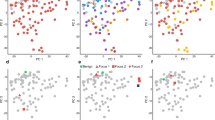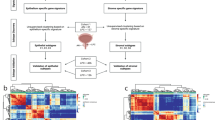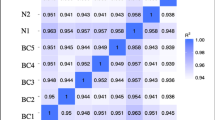Abstract
PTEN, a putative tumour suppressor gene associated with prostate and other cancers, is known to be located within the chromosomal region 10q23.3. Transcription of the PTEN gives rise to multiple mRNA species. Analyses by Northern blots, using cell lines which express PTEN together with cell lines which have lost the PTEN or carry a truncated version of the gene, has allowed us to demonstrate that the pseudogene is not transcribed. In addition, 3′ RACE studies confirmed that the multiple mRNA species arising from the gene probably result from the use of alternative polyadenylation sites. No evidence for tissue- or cell-specific patterns of transcription was found. Analysis by 5′ RACE placed the putative site for the start of transcription around 830 bp upstream of the start codon. A map of the location of the PTEN gene with a series of overlapping YAC, BAC and PACs has been constructed and the relative position of eight microsatellite markers sited. Two known and one novel marker have been positioned within the gene, the others are in flanking regions. The more accurate location of these markers should help in future studies of the extent of gene loss. Several polymorphisms were also identified, all were within introns. Four of the common polymorphisms appear to be linked. In blood, DNA from 200 individuals, including normal, BPH and prostate cancer patients, confirmed this link. Only two samples of 200 did not carry the linked haplotype, both were patients with advanced prostate cancer. It is possible that such rearrangements within PTEN could be evidence of predisposition to prostate cancer in this small number of cases. © 2000 Cancer Research Campaign
Similar content being viewed by others
Article PDF
Change history
16 November 2011
This paper was modified 12 months after initial publication to switch to Creative Commons licence terms, as noted at publication
References
Aveyard JS, Skilleter A, Habuchi T and Knowles MA (1998) Somatic mutation of PTEN in bladder cancer. Br J Cancer 80: 904–908
Bose S, Wang SI, Terry MB, Hibshoosh H and Parsons R (1998) Allelic loss of chromosome 10q23 is associated with tumor progression in breast carcinomas. Oncogene 17: 123–127
Brownstein MJ, Carpten JD and Smith JR (1996) Modulation of non-templated nucleotide addition by Taq DNA polymerase: primer modifications that facilitate genotyping. Biotechniques 20: 1004–1010
Cairns P, Evron E, Okami K, Halachmi N, Esteller M, Herman JG, Bose S, Wang SI, Parsons R and Sidransky D (1998) Point mutation and homozygous deletion of PTEN/MMAC1 in primary bladder cancers. Oncogene 16: 3215–3218
Cairns P, Okami K, Halachmi S, Halachmi N, Esteller M, Herman JG, Isaacs WB, Bova GS and Sidransky D (1997) Frequent inactivation of PTEN/MMAC1 in primary prostate-cancer. Cancer Res 57: 4997–5000
Cheney IW, Johnson DE, Vaillancourt MT, Avanzini J, Morimoto A, Demers GW, Wills KN, Shabram PW, Bolen JB, Tavtigian SV and Bookstein R (1998) Suppression of tumorigenicity of glioblastoma cells by adenovirus-mediated MMAC1/PTEN gene-transfer. Cancer Res 58: 2331–2334
Chumakov IM, Rigault P, Le Gall I, Bellanne-Chantelot C, Billault A, Guillou S, Soularue P, Guasconi G, Poullier E and Gros I (1995) A YAC contig map of the human genome. Nature 377: 175–297
Coy JF, Sedlacek Z, Bachner D, Delius H and Poustka A (1999) A complex pattern of evolutionary conservation and alternative polyadenylation within the long 3′′-untranslated region of the methyl-CpG-binding protein 2 gene (MeCP2) suggests a regulatory role in gene expression. Hum Mol Genet 8: 1253–1262
Dahia PLM, FitzGerald MG, Zhang X, Marsh DJ, Zheng Z, Pietsch T, von Deimling A, Haluska FG, Haber DA and Eng C (1998) A highly conserved processed PTEN pseudogene is located on chromosome band 9p21. Oncogene 16: 2403–2406
Di Cristofano A, Pesce B, Cordoncardo C and Pandolfi PP (1998) PTEN is essential for embryonic-development and tumor suppression. Nat Genet 19: 348–355
Duerr EM, Rollbrocker B, Hayashi Y, Peters N, Meyer-Puttlitz B, Louis DN, Schramm J, Wiestler OD, Parsons R, Eng C and von Deimling A (1998) PTEN mutations in gliomas and glioneuronal tumors. Oncogene 16: 2259–2264
Feilotter HE, Nagai MA, Boag AH, Eng C and Mulligan LM (1998) Analysis of PTEN and the 10q23 region in primary prostate carcinomas. Oncogene 16: 1743–1748
Fujii GH, Morimoto AM, Berson AE and Bolen JB (1999) Transcriptional analysis of the PTEN/MMAC1 pseudogene, ψPTEN. Oncogene 18: 1765–1769
Giri D and Ittmann M (1999) Inactivation of the PTEN tumor suppressor gene is associated with increased angiogenesis in clinically localized prostate carcinoma. Hum Pathol 30: 419–424
Gray IC, Phillips SM, Lee SJ, Neoptolemos JP, Weissenbach J and Spurr NK (1995) Loss of the chromosomal region 10q23–25 in prostate cancer. Cancer Res 55: 4800–4803
Gray IC, Stewart LMD, Phillips SMA, Hamilton JA, Gray NE, Watson GJ, Spurr NK and Snary D (1998) Mutation and expression analysis of the putative prostate tumour-suppressor gene PTEN. Br J Cancer 78: 1296–1300
Kim SK, Su LK, Oh Y, Kemp BL, Hong WK and Mao L (1998) Alterations of PTEN/MMAC1, a candidate tumor-suppressor gene, and its homolog, PTH2, in small cell lung cancer cell lines. Oncogene 16: 89–93
Knudson AG Jr (1991) Overview: genes that predispose to cancer. Mutat Res 247: 185–190
Li DM and Sun H (1997) TEP1, encoded by a candidate tumor suppressor locus, is a novel protein tyrosine phosphatase regulated by transforming growth factor B. Cancer Res 57: 2124–2129
Li J, Yen C, Liaw D, Podsypanina K, Bose S, Wang SI, Puc J, Miliaresis C, Rodgers L, McCombie R, Bigner SH, Giovanella BC, Ittmann M, Tycko B, Hibshoosh H, Wigler MH and Parsons R (1997) PTEN, a putative protein-tyrosine-phosphatase gene mutated in human brain, breast, and prostate-cancer. Science 275: 1943–1947
Liaw D, Marsh DJ, Li J, Dahia PLM, Wang SI, Zheng Z, Bose S, Call KM, Tsou HC, Peacocke M, Eng C and Parsons R (1997) Germline mutations of the PTEN gene in Cowden disease, an inherited breast and thyroid cancer syndrome. Nat Genet 16: 64–67
Maehama T and Dixon JE (1998) The tumor-suppressor, PTEN/MMAC1, dephosphorylates the lipid second messenger, phosphatidylinositol 3,4,5-trisphosphate. J Biol Chem 273: 13375–13378
Maier D, Zhang Z, Taylor E, Hamou MF, Gratzl O, van Meir EG, Scott RJ and Merlo A (1998) Somatic deletion mapping on chromosome 10 and sequence analysis of PTEN/MMAC1 point to the 10q25–26 region as the primary target in low-grade and high-grade gliomas. Oncogene 16: 3331–3335
Marsh DJ, Dahia PL, Zheng Z, Liaw D, Parsons R, Gorlin RJ and Eng C (1997) Germline mutations in PTEN are present in Bannayan-Zonana syndrome [letter]. Nat Genet 16: 333–334
Myers MP, Stolarov JP, Eng C, Li J, Wang SI, Wigler MH, Parsons R and Tonks NK (1997) PTEN, the tumor suppressor from human chromosome 10q23, is a dual-specificity phosphatase. Proc Natl Acad Sci USA 94: 9052–9057
Rajagopalan LE and Malter JS (1997) Regulation of eukaryotic messenger RNA turnover. Prog Nucleic Acid Res Mol Biol 56: 257–286
Rasheed BKA, Stenzel TT, McLendon RE, Parsons R, Friedman AH, Friedman HS, Bigner DD and Bigner SH (1997) PTEN gene mutations are seen in high-grade but not in low-grade gliomas. Cancer Res 57: 4187–4190
Rastinejad F and Blau HM (1993) Genetic complementation reveals a novel regulatory role for 3′ untranslated regions in growth and differentiation. Cell 72: 903–917
Risinger JI, Hayes K, Maxwell GL, Carney ME, Dodge RK, Barrett JC and Berchuck A (1998) PTEN mutation in endometrial cancers is associated with favorable clinical and pathological characteristics. Clin Cancer Res 4: 3005–3010
Robertson GP, Furnari FB, Miele ME, Glendening MJ, Welch DR, Fountain JW, Lugo TG, Huang HJ and Cavenee WK (1998) In vitro loss of heterozygosity targets the PTEN/MMAC1 gene in melanoma. Proc Natl Acad Sci USA 95: 9418–9423
Rowley G, Saad S, Giannelli F and Green PM (1995) Ultrarapid mutation detection by multiplex, solid-phase chemical cleavage. Genomics 30: 574–582
Steck PA, Pershouse MA, Jasser SA, Yung WKA, Lin H, Ligon AH, Langford LA, Baumgard ML, Hattier T, Davis T, Frye C, Hu R, Swedlund B, Teng DHF and Tavtigian SV (1997) Identification of a candidate tumour supressor gene, MMAC1, at chromosome 10q13.3 that is mutated in multiple advanced cancers. Nat Genet 15: 356–362
Tamura M, Gu J, Danen EH, Takino T, Miyamoto S and Yamada KM (1999) PTEN interactions with focal adhesion kinase and suppression of the extracellular matrix-dependent phosphatidylinositol 3-kinase/Akt cell survival pathway. J Biol Chem 274: 20693–20703
Tamura M, Gu J and Yamada KM (1998) Tumor-suppressor PTEN inhibition of cell invasion, migration, and growth involvement of focal adhesion kinase. Mol Biol Cell 9: 1429–1429
Tashiro H, Blazes MS, Wu R, Cho KR, Bose S, Wang SI, Li J, Parsons R and Ellenson LH (1997) Mutations in PTEN are frequent in endometrial carcinoma but rare in other common gynecological malignancies. Cancer Res 57: 3935–3940
Teng DHF, Hu R, Lin H, Davis T, lliev D, Frye C, Swedlund B, Hansen KL, Vinson VL, Gumpper KL, Ellis L, El-Naggar A, Frazier M, Jasser S, Langford LA, Lee J, Mills GB, Pershouse MA, Pollack RE, Tornos C, Troncoso P, Yung WKA, Fujii G, Berson A, Bookstein R, Bolen JB, Tavtigian SV and Steck PA (1997) MMAC1/PTEN mutations in primary tumor specimens and tumor-cell lines. Cancer Res 57: 5221–5225
Whang YE, Wu X, Suzuki H, Reiter RE, Tran C, Vessella RL, Said JW, Isaacs WB and Sawyers CL (1998) Inactivation of the tumor suppressor PTEN/MMAC1 in advanced human prostate cancer through loss of expression. Proc Natl Acad Sci USA 95: 5246–5250
Author information
Authors and Affiliations
Rights and permissions
From twelve months after its original publication, this work is licensed under the Creative Commons Attribution-NonCommercial-Share Alike 3.0 Unported License. To view a copy of this license, visit http://creativecommons.org/licenses/by-nc-sa/3.0/
About this article
Cite this article
Hamilton, J., Stewart, L., Ajayi, L. et al. The expression profile for the tumour suppressor gene PTEN and associated polymorphic markers. Br J Cancer 82, 1671–1676 (2000). https://doi.org/10.1054/bjoc.2000.1211
Received:
Revised:
Accepted:
Published:
Issue date:
DOI: https://doi.org/10.1054/bjoc.2000.1211



